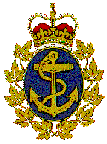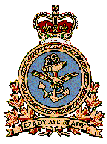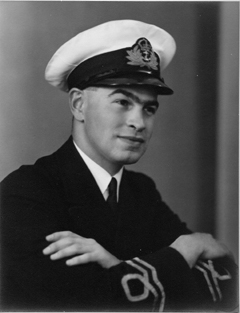December 31st, 1940
MEDICAL OFFICER'S JOURNAL
The Ship
H.M.C.S. "Prince Robert" was commissioned on July 31st, 1940. By using
the term "commissioned", the usual sense of the word must be forgotten
for at that time she was not fitted completely, nor stored for sea service.
In the following two weeks a great deal of work was done in every
department; many changes were desired and many articles of stores and equipment
were urgently needed. Suffice to say, that in one way or another most of
those needed were obtained prior to the ship's first entrance into actual
war service. The details of this will be found below, as applied to the
Medical department, yet in principle apply to the whole ship.
H.M.C.S. "Prince Robert" was built at Cammel-Lairds in 1929 and
engaged in the Pacific Coast passenger traffic until 1939. She was then
acquired from the Canadian National Steamship Company and converted to
an Armed Merchant Cruiser of some 7000 tons. Her complement has remained
at 250 officers and men during the first four months of service.
As a converted passenger ship she cannot be compared accurately
to any type of war vessel as regards living conditions, for her general
plan remains that of a merchant ship. A cruiser of similar tonnage would
most likely have a complement dearly double that of "Prince Robert's".
As a result, the mess decks of the ship are more commodious, have more
air space per person, and offer more space for recreation than any true
cruiser. They are nevertheless, well filled at the present, for tables,
lockers, cupboards, are built in allowing for the authorized, not the hypothetical
cruiser's complement.
The ship was designed for cruising in temperate climates, so that
no provision for tropical work (cork lined deck head, extra insulation
of the ship's sides, insulation of boiler room updraft) was made. In the
tropics, where the temperature of the sea water has reached as high as
96 degrees F. on this trip, the temperatures of the lower mess decks and
Officers cabin flat has on numerous occasions mounted as high as 110 degrees,
and less often as high as 115 and 116 degrees. In the boiler rooms 135
to 140 degrees has been relatively common. With these temperatures any
additional complement could not, with impunity, be messed below. Where
deadlights are closed at sunset, and the humidity is over 75%, living conditions
below decks become extremely difficult. Needless to say, sleeping on the
upper decks is common.
Ventilation of the ship is carried out by a plenum system of fans;
the air being expelled from the conduits through "Punkah Louvers". A large
number of 14" electric fans are scattered throughout the ship and run almost
continually in tropical weather. There are no "Punkah" fans mounted in
the Wardroom, Galley, or indeed anywhere in the ship. A simple plenum system
of ventilation, with deadlights down, is certainly not the method of choice
in hot climates, but substitution of a combined plenum exhaust system would
be impracticable. With open ports, or even in a temperate climate, it would
be unnecessary in this ship. Steam heated radiators are present throughout
cabins and mess decks. Some parts of the ship, it should be added, have
exhaust pipes leading form them, but this in not universal, by any means.
In summing up the "weather worthiness" of the ship from hygienic
grounds it becomes apparent from the foregoing that in the climate for
which the ship was designed, she is quite satisfactory; for the tropics,
something is left to be desired. With any larger crew this would become
very obvious and would influence the health of the crew adversely.
General Hygienic Considerations
Washing facilities are good, as an abundance of hot and cold sea
water is available, with enough showers to make washing easy. Urinal troughs,
water closets in sufficient numbers are installed in the heads at various
parts of the ship. The enameled cast iron water closets in the Port after
heads show discolouration impossible to clean off due to their exposure
to sea water. The porcelain bowls, of course, found further forward, can
be readily cleaned. In the washing places and heads installed in reconditioning
the ship, a decking of an asphalt like material was put in. While this
is a good type of base for any flooring, it is not entirely satisfactory
by itself in these situations. It will not hold paint, it is dirty despite
cleaning, and it holds water. A layer of plastic material would render
these places more hygienic, easier to clean and more pleasing in appearance.
The subject of washing cannot be passed over without some mention
of the laundry. A "dobeying firm" operates in the ship with questionable
success as regards results. It is self supporting, and in peace time might
be satisfactory enough. When cruises of many months are taken, laundry
becomes an important item, which at the present, is not handled to the
best possible advantage.
Water is fortunately a subject with needs little mention, as its
supply seems assured; it is pure, satisfactory for drinking and all other
purposes. Two sources of supply are available, first the large storage
tanks, capacity 372 tons, and secondly an efficient distilling plant producing
20 to 25 tons per day, exclusive of engine room requirements.
The ship's company, officers and men, are young and for the most
part in robust health. As it is a Canadian crew, their background has an
international flavour, not found in R.N. ships. Not only do descendants
of the Rose and Thistle, Shamrock and Fleur de Lis form their body, but
Italy, Russia, Germany and the Scandinavian Countries may claim their forebears
place of origin. A reserve crew, for the most part, many are less than
six months away from the prairie cities of Fraser River valley. Its variegated
nature, its meager training, its diverse origin, has become less apparent
as week has succeeded week, and month succeeded month in the ship's commission.
In place of not knowing what was expected of them, and not knowing how
to meet new problems which arose, the watch can now cope well with most
situations with which they are confronted.
The health of the ship's company has been excellent, perhaps better
than could be expected. This can be accounted for largely by the fact mentioned
above, that almost all are young and healthy to start with. Physical training
classes are carried out under the supervision of Sub Lieutenant Dundas
almost daily. The food is supervised as well as possible under prolonged
cruising conditions. Yet with leave negligible from the time of commissioning,
the physical condition of the crew remains surprisingly good.
It is noticeable that at the present (the latter part of December)
lookouts have a greater tendency to sleep whilst on duty, muscular aches
and pains, indigestion, dental cases, and unhealthy conditions of the mouth,
are becoming much more common than heretofore.
Conditions of service probably account for these facts, in that
a three watch system has been operating continuously since 12th September
1940, with the exception of part of a busy week spent in Esquimalt early
in October 1940. This means that at no time have any of the lookouts had
a full 8 hour sleep since leaving Vancouver in September 1940. Under these
conditions, the question of diet becomes more important than under those
in which shore leave, no matter how short, is available. While complaints
are relatively infrequent, naturally a few have been received. While in
actual Caloric intake nothing is to be desired, yet in vitamin content,
and type of meal, especially in the tropics, it is believed that improvement
could be made. Storing, menu, cost, preparation and serving enter into
the problem of improving the dietary.
It is not the purpose of this report to discuss at any length
the victualling problems of the ship, but a few general remarks will be
made. The type of meal eaten in Canada is quite different to that eaten
in Great Britain in corresponding strata of society. There is more variety,
more green vegetable consumption, and less heavy food found in the average
meal. With store lists and menus from R.N. sources it is almost inevitable
that meals should be "English" – not "Canadian". Institutional feeding
in civil shore establishments has greatly advanced of late years, combining
adequate food intake, economicality[sic], with other desired qualities
of variety, higher vitamin content, [and] ease in serving. Storing difficulties,
the difficulties attendant in buying vegetables and meats in foreign ports
(quality, cost, exchange, presence of amoebic cysts) might well be obviated
by having quantities of vegetables and fruits in economical sized cans
added to the ship's stores. In individual messes, such as are now existant
[sic] in H.M.C Ships, this would, in addition to ensuring an adequate vitamin
intake, guarantee a standard good quality product, well prepared at a price
easily comparable to that of the raw article, not after 3 days, 3 weeks
or 3 months, but any length of time after leaving port,. At first sight
the economy of this might seem doubtful, but considering storage spoilage,
waste in preparing and waste in and after distribution, the economical
nature of the suggestion immediately becomes apparent to those familiar
with food supply problems, With three or four cooks authorized (for the
most part poorly trained) for 230 men, the advantage of having prepared
or semi-prepared food need not be explained further.
In H.M.C.S. "Prince Robert" as in all other H.M.C. Ships familiar
to the writer, general messing, with eating in separate messes is the system
in force. From a dietary standpoint, it is considered that general messing
in a common mess space or recreation space would be preferable. Doubtless
there are well-founded arguments against this scheme of organization.
The advice of a dietician might be obtained in planning stores
and menus more applicable to H.M.C. Ships. As mentioned above, many minor
illnesses have occurred without actually disabling ratings from carrying
out their duties.. It is quite possible that a good many of them are due
to vitamin poor diets. While the modern "Lime-juicer" certainly does not
suffer from scurvy, beri-beri, pellagra, or rickets, attacks of neuritis,
recurrent pyorrhea, nyctalopia, myositis, [or] indigestion may frequently
indicate the same deficiency in a lesser degree.
Venereal disease cases have remained at a low figure, despite
their prevalence ashore. Free distribution of condoms, a prophylactic station,
instruction in V.D., and periodic inspections have been carried out. Cooperation
in the above from the ship's company has kept the incidence extremely low
for all types of venerial [sic] and infectious skin diseases. It is an
interesting fact that there have been no cases up to now where the recommended
prophylaxis has been carried out.
Sick Bay
The Sick Bay is situated in the Starboard side of the ship, abaft
the beam, and forward of the recreation space. It consists of heads (3),
basins (3), a freshwater bath in the forward space; the ward, in which
three double-decker beds of very heavy, angle iron, construction are placed,
[and] a mess table. Storage cupboards and shelves for linen, blankets,
medical stores, are built in the inner bulkhead. A small M.O.'s office
and reception corridor and small surgery complete the picture. The ward
is 18' x 17 ½' x 8' = 2520 cubic feet of air space, or just over
400 cubic feet per patient, when full. There is no Sick Berth Attendant's
Mess, the staff sleeping in the ward or, when this is occupied, in the
surgery. Lockers are needed for the two S.B.A's gear. A large cupboard
has been built in the M.O.'s office for stowage for medical comforts, blankets
and utensils for rigging dressing stations. This will obviate the hasty
mustering of various articles from different stores in the ship in case
of an action.
The Sick Bay has recently been painted with a soft non-glaring
green enamel throughout, excepting deck head and beads with remain white.
This colour combination is pleasing and much more restful than the dead
white previously used. Corticene is on the decks, except in the heads,
bathroom, surgery which have the asphalty covering previously mentioned
as unsatisfactory in like places elsewhere. Taken by and large, the position
and size, and plan of the Sick Bay is superior to that of most ships and
is eminently satisfactory.
Stores and Equipment
Reference has already been made that on commissioning the ship,
medical storing and equipment left something to be desired. This was due
to several reasons – (1) R.N. stores and equipment are not all available,
nor are they all in current use, in Canada. (2) There was apparently no
person in charge of overseeing, supplying, or equipping the Medical Department
of the ship. Bearing in mind the necessity of substitution under the circumstances
(viz. (1) above) it was necessary that arrangements be made early if the
final result was to be successful, yet with the situation (viz. (2) above)
this was impossible. It is not intended in this report to quote every omission,
(some of which have now been rectified), yet an example of surgical instruments
now on charge will be quoted. In the Scale of Medicines (1936) it will
be noticed that "1 chest of Surgical Instruments (Naval Pattern) weight
232 pounds" is authorized (p.4). A small case of surgical instruments weight
20 pounds was received from Central Medical Stores, Ottawa, with "Major
Case of Operating Instruments for Royal Navy (Modified)" noted on the packing
note. Actually this case is the Army (1922) Pattern, a different and vastly
smaller set of instruments. Other omissions were of a similar yet fortunately
less serious nature. A few of the deficiencies were made up prior to sailing,
some others when the ship returned to Esquimalt in October 1940, some still
remain. This subject is mentioned with the sole desire that in the future
similar cases will not occur. It is strongly recommended that measures
be taken to ensure that they don't.
With reservations as mentioned in the previous paragraph, the
equipment is of good quality and adequate in quantity for any situation
that might arise.
In conclusion, I must mention the cooperation in all things which
I have received from the Sick Berth Staff, the department heads, Commander
G.B. Hope, Lieutenant Commander (E) Hinchcliffe, Paymaster Lieutenant Commander
W.E. Adamson, and the Captain of the ship, Commander F. G. Hart.
Respectfully submitted,
(E.A. Sellers)
Surgeon Lieutenant, RCNVR.
~ Sandy Sellers
Glenburnie, Ontario
Text and Photos© Estate of E. A. Sellers




![]() Home
Port
Home
Port
